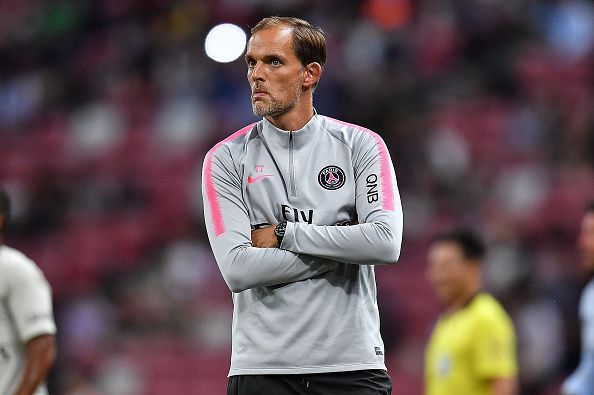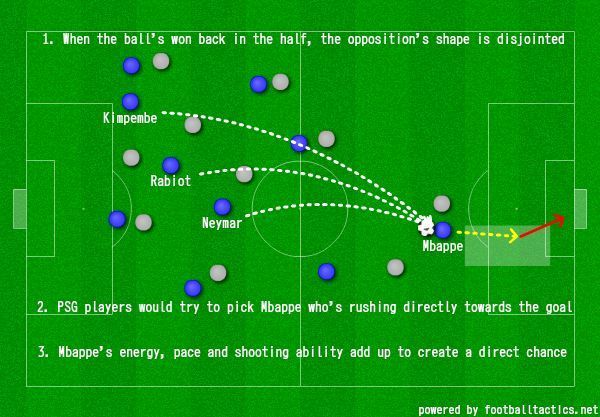
New Beginnings - PSG under Thomas Tuchel
PSG is a modern club with high maintenance and ambitious goals. The Qatari owners who took over the club in 2011 have been harnessing domestic dominance since, with PSG going on to win the league title 5 times in the last 7 years. The next milestone is the cherished Champions League and winning it would set the project in concrete.
The project also demanded a definitive footballing philosophy of which playing a style of attacking football was fundamental to achieve global adulations. Firstly, PSG built a roster of exceptional players all over the pitch and is not afraid to loosen the purse strings one bit. The stars include the likes of Neymar, a global icon, and Mbappe, a teenage sensation - both of them were signed on for world record fees.
PSG remain flexible and open to change with the coaching role since the takeover. Thomas Tuchel is the 4th coach appointed as we enter the 9th year under the new leadership.

Tuchel’s previous job was coaching Borussia Dortmund succeeding Jurgen Klopp in the process. His side played some scintillating football - dynamic and direct going forward, intense and committed going back. One touch passes and high presses were the most identifiable traits of the German side and it was a treat to watch them.
With the high ambitions of the PSG project, the owners would like Tuchel to apply his philosophy on a better squad and set the platform to attain heights that were never seen before by the Paris faithful.
The Shape
Tuchel’s tactical flexibility was on display in the first month of the season as PSG lined up in 3 different systems: 4-3-3, 3-4-3 and 4-2-3-1. With Tuchel generating valuable feedback as to what shape would best suit the team, central build-ups to the goal and pressing partnerships were two constant traits all through. There were mistakes committed at various times but that was to be expected as the team develops the Tuchel’s sense of football.
Buffon and Aerola share the duties between the posts, the former in particular does not seem to have lost his aura, pulling off impressive saves against a spirited Guingamp side. Thiago Silva is a rock at the back with the impressive Kimpembe evolving under his guidance.

The midfield is commanded by Adrien Rabiot who with his impressive passing range and solid defensive work is instrumental at retaining balance in a seemingly attack heavy PSG side. Marquinhos has been refreshingly slotted into the midfield in the absence of Marco Veratti. His demeanour and discipline helped in maintaining the shape for long periods of play.
Neymar slots into the number 10 role naturally. Not only is he good at delivering impressive passes opening up spaces for others, Neymar also tends to fall back and pick up the ball from the defenders to drive forward. This allows Neymar to dictate the game with more authority when compared to being stationed on the left wing. Mbappe predominantly operates from the right side with Di Maria starting off on the left.
On the Ball Play
Build through the Middle
PSG builds the attack from the keeper as the midfielders, who receive the ball from the centre-backs, try to dribble or create one-twos to surge forward through the middle. The ball would later land at the forwards like Neymar or Mbappe who would attract the rival press to the middle of the pitch thereby leaving space on the wings to run into. A lay-off pass into the path of the onrushing wing players would lead to a dangerous cross with the likes of Cavani and Mbappe ready to feed upon.
There is also an upside to this style. The individual players back themselves to receive passes in tight areas and commit to coming out of those spaces all by themselves. Though they’re able to pull it off often, the players are ending up losing the balls more than a handful of times, thereby opening up counter situations for the opposition.

Through Balls
With the player quality available upfront for PSG, the team does not shy away from relying on the creative ability of its players on the pitch. The forwards try out inspired and inventive sequences of play to create direct chances. One of the hallmarks of this is to send a through ball to the player who makes the run behind the defender in the final third to get into a one on one situation with the goalkeeper.
Pulling off these sequences consistently would require both the passer and the runner to be perfect with timing their actions, leaving it breathtaking to watch but requiring immaculate skill and practice to execute.
Long Balls During Transition
PSG have an exceptional talent in Mbappe who seems to be worth every penny paid and more. PSG seems deadly during the transitions from deep in their half turning defence to attack in a matter of seconds and Mbappe is elemental in its execution.
As the PSG players win the ball back in their half, one of the first instincts is to sight Mbappe and send out an aerial pass into his path. Mbappe skills are on display in this sequence - he accelerates to reach the ball, out powers the defender trying to mark, controls the ball that generally comes from behind with his first touch and then sets himself up for a shot. These occurrences are special and elevate the player to a different level.

Off the Ball Play
The Pressing Game
Tuchel urges his players to win the ball back as soon as possible once they lose the possession. The consequence is the high-intensity pressing he intends from the players at various areas of the pitch. Once the ball is lost, the players around would work together to press the opposition, exhaust space and time for them. This leaves the opponent to take decisions under pressure thereby affecting the accuracy.
If executed well, opposition ends up sending out long balls in hope to find the forwards, which would make it an easier job for the defenders to cover. Or, their sequences would be squeezed with players tackling and intercepting to win the ball back and enable transitions.
There is an upside though. If the rivals come out from the first line of pressing where PSG put in as many numbers as possible, there will be open spaces to run into and can leave PSG running for the game.
Forwards Role in Defence
Forward play is the driving force on the pitch for PSG as they keep trying to create something all through the match. This coupled with the players backing themselves, sometimes ambitiously, to wrestle out of tight spaces all by themselves lends the possession to the opposition.
Forwards participate in the first act of pressing with purpose and receiving help from the midfield. However, once the rivals break that and move on, the forwards tend to give up and not fall back. This makes it difficult for the midfielders and the defenders to win it back if they are not on the top of their game.

The forwards have to share the responsibility falling back too so that the opposition would be cut off of opportunities.
Looking Ahead
Tuchel has an exceptional team in his hands and they have started off smoothly by winning all the matches that have come their way. There would be tougher tests, particularly in Champions League where the spaces would be not simple to exploit.
There is also a sense of over-reliance on the superlative abilities of the players to create something out of nothing. With time, Tuchel should come up with a concrete plan that would enable the goal scoring even if the stars are having a difficult outing.
Lastly, There are far too many players in the front line who are not up to run for the ball. Tuchel should ensure that the forwards have enough reasons to fall back and work to wrestle possession. That would enable something special to come out of this group.